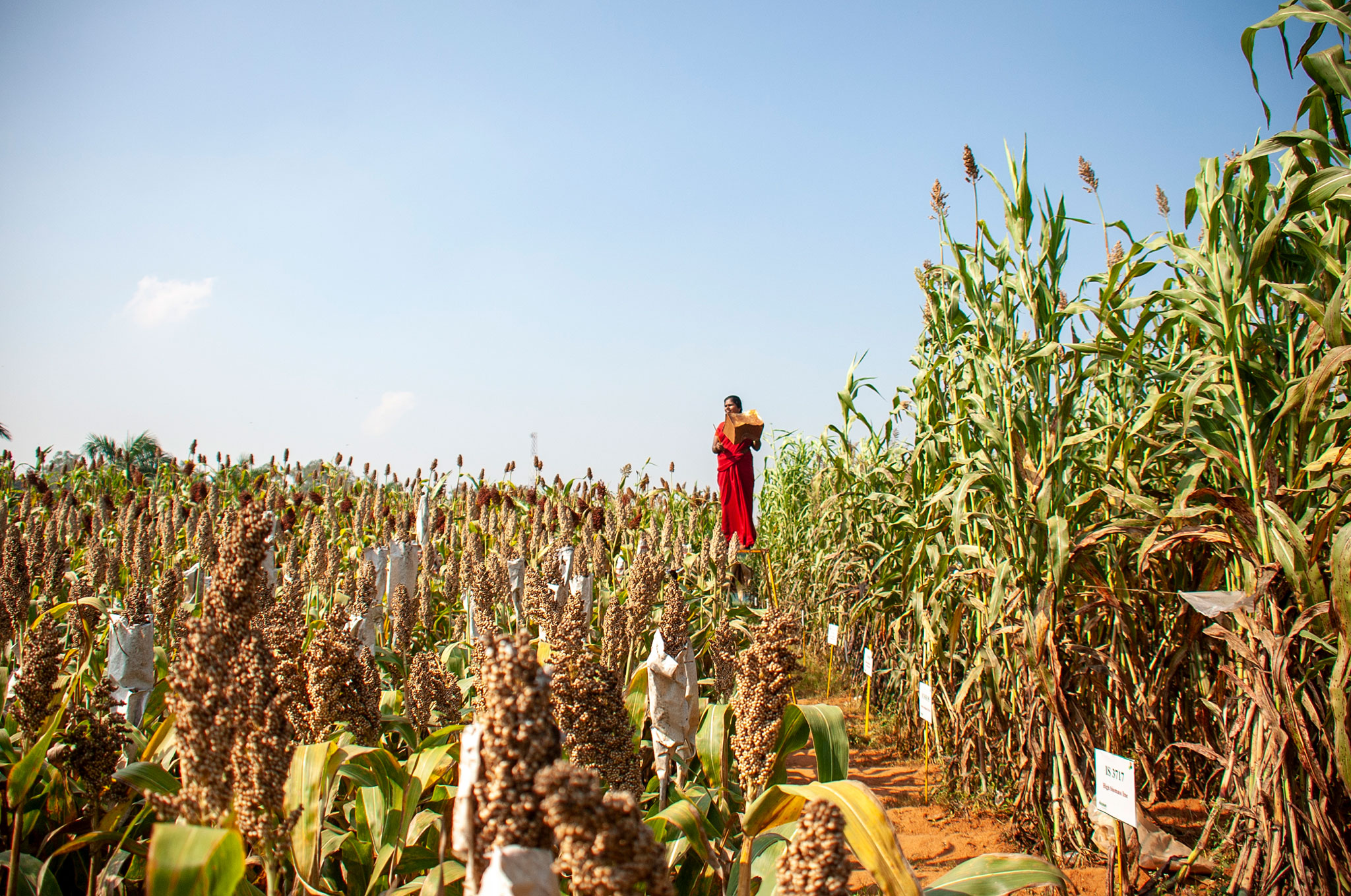Scientific name: S. bicolor.
Common name: Jowar (Hindi) Jonna (Telugu) Juara (Oriya) Mtama (Swahili) Sorgho (French)
ICRISAT is at the forefront of innovative and impactful sorghum research and breeding, dedicated to developing improved varieties with enhanced characteristics. With a focus on addressing the diverse challenges faced by farmers and consumers, ICRISAT's sorghum breeding efforts encompass a range of key objectives:
Higher Yield: Recognizing the importance of better income for farmers, ICRISAT is actively involved in breeding sorghum varieties with desirable agronomic traits, such as early maturity and short-duration varieties, to achieve higher yields.
Drought Tolerance: Sorghum is frequently cultivated in regions prone to water scarcity, making drought tolerance a critical trait. ICRISAT is dedicated to developing sorghum varieties that can withstand prolonged periods of water stress while maintaining reasonable yields, ensuring greater resilience for farmers in dry areas.

Pest and Disease Resistance: Sorghum is vulnerable to various pests and diseases, including shoot fly, midge, and downy mildew. By employing advanced breeding techniques, ICRISAT is working to develop resistant varieties, reducing the need for chemical pesticides and minimizing crop losses due to these challenges.
Improved Nutritional Traits: ICRISAT is committed to enhancing the nutritional quality of sorghum grains. The breeding program targets varieties with higher protein content, improved amino acid profiles, and elevated levels of essential micronutrients, contributing to improved food and nutritional security.
Striga Weed Resistance: The parasitic weed Striga poses a significant threat to sorghum and other crops. ICRISAT's research focuses on developing sorghum varieties resistant to Striga infestation, mitigating yield losses and enhancing productivity for farmers.
Dual Purpose Sorghum and Forage Sorghum: ICRISAT's pioneering sorghum breeding program seeks to combine both grain and forage traits in varieties. This allows farmers to benefit economically from both grain production and forage utilization, providing a more diverse and sustainable approach to sorghum farming. India's remarkable 'multi-cut' forage hybrid CSH 24 MF stands as a landmark development achieved using ICRISAT breeding material as one of the parents.
Through a multi-faceted approach and collaboration with various partners and stakeholders, ICRISAT remains dedicated to advancing sorghum breeding and research, ultimately contributing to improved livelihoods, agricultural sustainability, and food security for communities worldwide.
ICRISAT's commitment to advancing agricultural research and breeding is underscored by its constant review and updating of market segments for each crop, accomplished through meaningful consultations with diverse stakeholders. These well-defined market segments are pivotal in prioritizing breeding traits that align with current challenges facing crop production and aligning with the preferences of farmers, consumers, processors, and other key players in the agri-food value chain.
For sorghum, ICRISAT's dynamic breeding program is currently focusing on four distinct market segments, each with its unique set of traits:
Post-Rainy Season Sorghum for Food and Fodder:
Maturity Duration
Grain Yield
Stover Yield and Digestibility
Resistance to Shoot Fly and Charcoal Rot
Seed Size, Grain Color, and Luster
Rainy Season Sorghum for Food, Feed, and Fodder:
Maturity Duration
Grain Yield
Stover Yield and Digestibility
Resistance to Shoot Fly and Grain Mold
Forage Sorghum:
Forage Yield and Digestibility
Tillering Capacity
Resistance to Anthracnose and Leaf Blight
Resistance to Stem Borer
Suitability for Single Cut or Multi-Cut Harvesting
Sweet Sorghum and High Biomass Sorghum for Biofuel:
Maturity Duration
Fresh Stalk and Dry Stalk Yield
Brix % (Sugar Content)
Resistance to Shoot Fly and Stem Borer
Resistance to Anthracnose and Leaf Blight
ICRISAT's dedicated sorghum breeding efforts are driven by a deep understanding of the diverse needs of end-users and markets. By prioritizing these specific traits for each market segment, ICRISAT aims to develop improved sorghum varieties that are better suited to meet the demands of farmers, industries, and consumers alike. Through this strategic and inclusive approach, ICRISAT continues to play a vital role in enhancing sorghum productivity, resilience, and sustainability to positively impact the livelihoods and food security of millions of people worldwide.
By concentrating on these distinct market segments, ICRISAT aims to cater to the diverse needs of different stakeholders, ensuring that groundnut varieties meet specific requirements for oil extraction, home consumption, food preparation, snacks, and confectionary purposes. This strategic approach not only addresses the current challenges faced by the groundnut industry but also aligns with the preferences and demands of consumers and the agri-food value chain stakeholders.
Should you have any questions our dedicated support team is ready to help. Please email: research@icrisat.orga